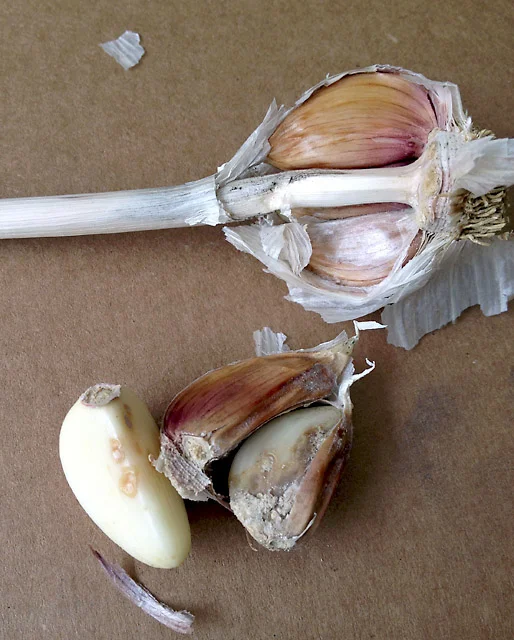Experience of Soil
I pull several bundles of garlic from the loft, bring them down to ground level, trim them of their leaves and roots, and then squeeze, sniff, poke each clove. If all is satisfactory, the bulb is further cleaned. At first culling, I've been losing about 20% to Botrytis mold, depending on variety. Once the bulbs are in the Brooklyn studio, I lose another 10-15% over a seven day period. On top of my other losses earlier in the season, crop yield is about 40% of the total planted. I'm on target to lose 4000 bulbs.
The mold is a consequence of wet soil, said wet soil a consequence of too many rainy days and nights, daily fog and mist, until about July four, when they turn that stuff off for the sake of the crowd. By that date, most of my garlic has been harvested, yet what remains still gets to sit in wet soil. With soil like that, one can only hope for dry weather during harvest, like I had hoped for this season. It didn't work.
Most people comment on the sand that must be my growing medium, but most people don't really give too much thought to the diversity of soil types in what can be a very small area. My farm is predominantly BgA/BgB or Bridgehampton Silt Loam of between 0 and 6% slope. The soil is tight and holds water remarkably well, yet it is still classified as well-drained. The significant property, the available water capacity, is rated at 14.9 inches or very high. From the USDA and NRCS glossary of terms:
"Available water capacity (available moisture capacity)
The capacity of soils to hold water available for use by most plants. It is commonly defined as the difference between the amount of soil water at field moisture capacity and the amount at wilting point. It is commonly expressed as inches of water per inch of soil. The capacity, in inches, in a 60-inch profile or to a limiting layer is expressed as:
Very low: 0 to 3 Low: 3 to 6 Moderate: 6 to 9 High: 9 to 12 Very high: More than 12"
In other words, available water capacity describes how much water the soil will hold between deep rains or irrigation cycles and the point at which a plant will wilt due to lack of moisture.
For comparison, take a look at Southold farmland, near the barn where I cured my garlic. We have two predominate soil groups, RdA and HaA or Riverhead Sandy Loam and Haven Loam of 0 to 2-3% slope. The available water capacity of these soil types is between 4.3 and 5.1 inches or very low. This means plants here will wilt far sooner than plants at the Amagansett farm. Now, don't get me wrong, I do not want the plants to wilt. However, I would rather irrigate when needed over waiting for the rain to stop and watching the bulbs rot in the field or barn. I've decided, if I am to step into another season, I need to set foot onto Haven loam (as was intended, but that is another story).
I spent the last two days packing garlic for folks all over the New York City and Long Island. Each bulb, every clove, has gentle pressure applied by my fingers several times. Each bulb also gets the sniff test, but this is less effective as the scent is not sulphureous, but only a very mild ferment of vegetation. Any bulb with a clove in doubt is rejected. The last thing I want to do is send out a bulb with a few moldy cloves, but even as each is subject to several checks over two weeks, I cannot see inside the clove where it may wait, only to bloom one or two weeks after it ships out. I cannot understand why, but it is worth noting, that not all the varieties are subject to the mold. Turban and Porcelain have had little to none, where as the Rocambole and Marbled Purple Stripe have had some to a lot.
No one decides to farm and finds that all has gone well. It's no different for a new garden. I've been thinking lately that a difference between gardening and farming is simply one's expectations. Gardeners can let things go, a lost tomato here, a rotten squash there, but the farmer is in it to produce! But then, just as a garden gets better with time, as you improve the conditions, so does the farm field. Things really begin to turn the corner around a garden's third year and year four often comes as a great surprise -how did all this happen?!



Comments
Post a Comment
Go ahead and comment! I will moderate and delete the spam. Thx